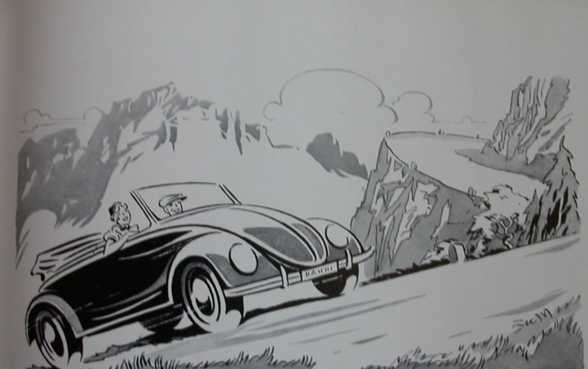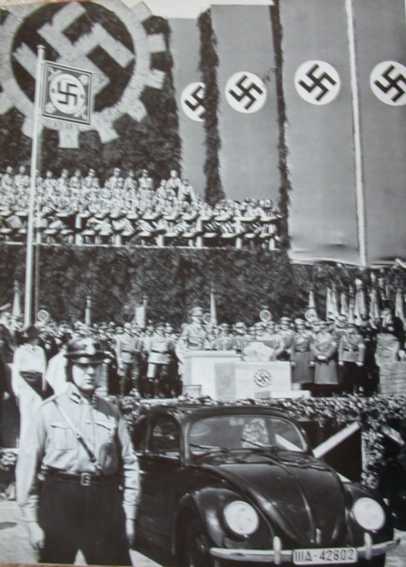

Background: The Volkswagen was a centerpiece of Nazism’s claims to benefit ordinary Germans. Hitler proposed to build a cheap car that almost anyone could afford. He gave it the name “KdF Wagen,” which we know as the Volkswagen. KdF was the abbreviation for “Kraft durch Freude” (Strength through Joy), a subsidiary of the Deutsche Arbeitsfront (German Labor Front), headed by Robert Ley. This chapter on the beginnings of the Volkswagen is taken from a book celebrating the achievements of “Kraft durch Freude.” As it turned out, not many people got their cars until after the war. As the chapter notes, the first deliveries were planned for early 1940, at which point the factory had been turned over to war production.
I’ve included six of the ten illustrations in the chapter. The missing pictures show scenes of factory construction and happy Italian workers.
The source: Unter dem Sonnenrad: Ein Buch von Kraft durch Freude (Berlin: Verlag der Deutschen Arbeitsfront, 1938), pp. 177-189.

The enormous expansion of the German high system, particularly the Reich Autobahn system, which like the growth in automobile manufacturing came from the Führer’s orders, looked far into the future. Both projects go along with each other, and today hardly anyone does not cheerfully support Adolf Hitler’s work in these areas. The Führer’s will that the entire people should benefit from their common labors has repeatedly shown itself in recent years. It was only natural that it was always close to Hitler’s heart that this also include those with limited incomes. At the automobile exhibitions during the first years after the takeover of power, he so clearly expressed his wish for a Volkswagen that the automobile industry had to consider it an order or a commission. As is known, in recent years the German automobile industry was barely able to produce enough of its own models in a reasonably timely fashion, even when fully using all its labor, plants, and machines.
 It
was thus no surprise that early in 1937 the Führer gave the leader
of the German Labor Front the order to use all the means of his organization
of millions of workers, along with the NS Community “Kraft durch
Freude,” to realize his dream. As early as 1934, he had talked with
the most famous German automotive engineer Dr. Porsche about carrying
out his thinking, and given him the commission to undertake the construction
of the German Volkswagen.
It
was thus no surprise that early in 1937 the Führer gave the leader
of the German Labor Front the order to use all the means of his organization
of millions of workers, along with the NS Community “Kraft durch
Freude,” to realize his dream. As early as 1934, he had talked with
the most famous German automotive engineer Dr. Porsche about carrying
out his thinking, and given him the commission to undertake the construction
of the German Volkswagen.
Early in May 1937, Dr. Ley carried out the Führer's commission to found the “Society for the Preparation of the German Volkswagen.” The manufacturer Dr. Porsche, the automotive expert J. Werlin, and the Reichsamtsleiter “Kraft durch Freude” Dr. Lafferentz were appointed the leaders of this organization.
The three party comrades worked hand in hand to determine the immediate tasks, and then to take up the factories, methods, and distribution of this new car. Dr. Lafferentz was responsible for a large part of the plan to construct a large factory to build the Volkswagen in Fallersleben, near Braunschweig. After long efforts, the whole plan took final form. The whole project had been organized. For years, one had heard little about the project until the Führer’s speech at the Automobile Exhibition in 1938 revealed the happy secret. Among other things, Adolf Hitler said: “Over the past four years, and with continual improvements, we have developed the Volkswagen, which we are convinced not only can be sold at the price we want, but also can be manufactured in ways that use a minimum of workers to produce the maximum amount. The model that has resulted from years of work by Dr. Porsche will undergo testing this year. It will enable millions of new customers with limited incomes to afford a car. We owe the best cars in the world to our directors, engineers, craftsmen, workers, and salesmen. Today, I am convinced that in a short time we will also build the least expensive cars.”